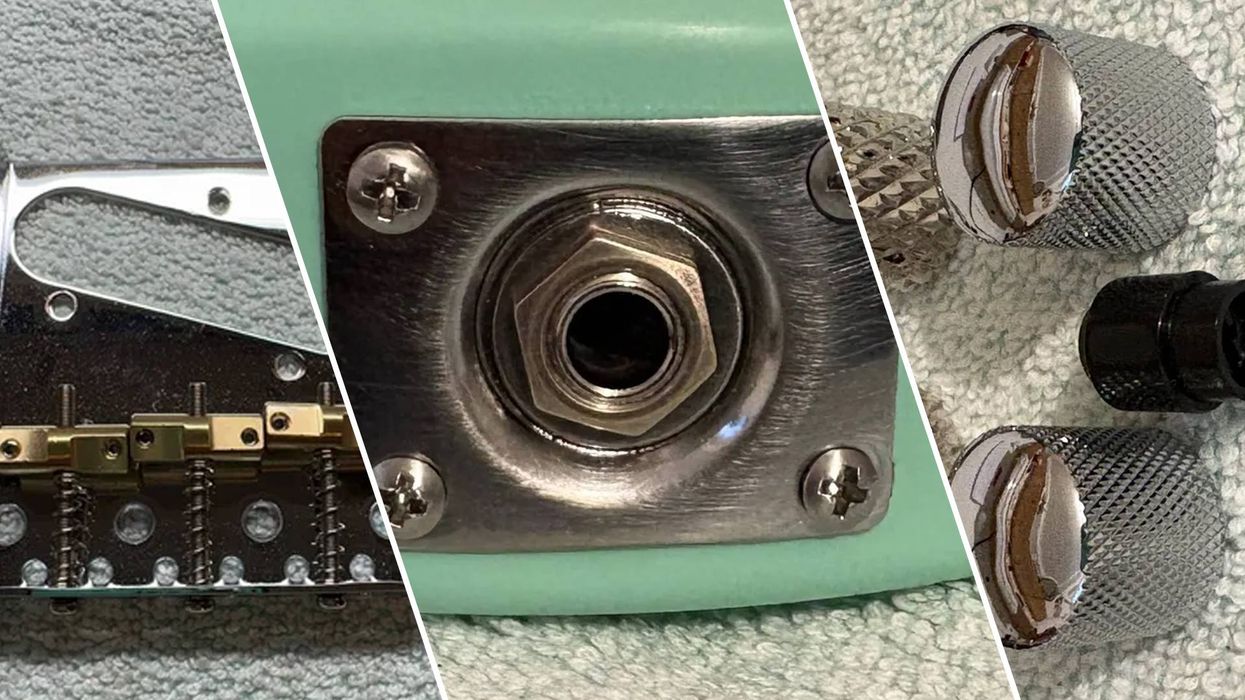As bassists, we’re used to peering into control cavities like this, but our guitarist buddies might faint at the sight.
Low-enders! Welcome to the Bass Bench, my new column about all things bass— from its fundamental frequencies to its fundamental musical mission. We’ll explore modding and also seek to understand your instrument and its main parts. We’ll cover basic maintenance and setup, and even ways to stay cool when your bass malfunctions in the most inappropriate moment.
Here at PG, there’s been a long tradition of offering modding and maintenance ideas for guitarists, but let’s face it, basses and bassists have different needs. While our colleagues are struggling with another attempt to rewire a 5-way switch and test out yet another vintage capacitor, we low-enders have already swapped in our fifth 36-volt, fully parametric 4-band EQ.
Basses have real strings too—not just those tiny .010" wires that are just a few times as thick as a human hair! Our mainly non-tube bass amps are burlier than guitar amps, as are our cabs. In short: Bass players embrace cuttingedge technology and care about big, tough rigs.
Though we might start by simply adding a new pickguard, our bass mods can include swapping electronics and pickups, replacing bridges and necks, and even attempting some Jaco-inspired fretless conversions. Whatever the mod, I like to categorize it as one of four types: visual, functional, ergonomic, or tonal. Categorizing a mod helps us focus on the desired outcome, but these categories can be less distinct than you might initially think.
For example, applying a new finish (which would come under the visual category) will often alter tone. Adding an ergonomic thumb rest might hurt functionality for slap-style playing. Balancing an instrument makes it more ergonomic, and that introduces a relaxed functionality for your left hand. And those new tuners (functional category) can shift sonic dead spots to where they really hurt. These things all connect, sometimes in unexpected ways.
So why consider modding? Maybe you’re unhappy with your bass in one of the categories we’ve outlined. Perhaps your playing has evolved and you want to make your instrument more suited to your current abilities. Or you want to get closer to that unaffordable dream bass. Or maybe you think tinkering is fun.
Perhaps you’re one of those players who needs to know how your main tool works, and you want to be prepared to make a quick repair or adjustment when faced with a problem in the studio or on tour. Most of us go through life without our own guitar tech. If an output jack breaks minutes before you go onstage—and it will, there’s a law about that—you’ll be left completely on your own. And you’ll be glad you’re not viewing your instrument’s innards for the first time.
Okay, when isn’t it a good idea to mod your bass? For starters, some mods can’t be reversed. Or they’ll hurt the resale value or blow your budget or make a particular problem even worse. Often, I have to slow customers down instead of just taking their money and doing the job. Remember, it’s best to move incrementally and take one step at a time. You can easily lose control by, say, changing pickups and electronics at the same time.
In terms of importance, here’s how I rank our four categories: functional, tonal, ergonomic, and finally visual. If the instrument lacks functionality—specifically good playability— I won’t invest any time or money into tonal mods, let alone a visual one. Your priorities might differ, but if you don’t feel that your current instrument is a real keeper, don’t waste too much time on it. That said, if you’re just doing mods for fun—a perfectly acceptable goal—get a low-budget instrument for your first experiments.
Another thing: Always keep the original parts and don’t be afraid to ask a luthier for help. A skilled pro should be able to give you some advice. The more you know about your instrument, the better you can judge if the repairperson is just looking for work or is eager to win you as a future customer.
Before you begin a project, ask yourself these questions: What’s my budget? What mods are the most effective? What’s the value of my instrument? Are there affordable replacements if I ruin it? Is it smart to start a project the day before my biggest, oncein- a-lifetime studio job? Am I just bored or fixing up the instrument to sell it?
Modifying your wiring is cheap, pretty predictable, and reversible. Conversely, spending your last bucks on your hero’s favorite pickup could turn into a huge disappointment if you don’t take other factors into account.
If you’re not happy with your instrument’s playability, visit your local dealer and test-drive a few basses. There’s a good chance your dream machine already exists. If not, you should take every chance to compare various basses, so you understand what you really want.
And finally, don’t spend your whole budget on a new finish unless you really love the rest of the bass. Even then, think twice: Function rules!
In my next columns, we’ll heat up the soldering iron and try some basic wiring projects. The goal will be to learn what can break most often and how to fix it on your own. See you then!








![Rig Rundown: AFI [2025]](https://www.premierguitar.com/media-library/youtube.jpg?id=62064741&width=1245&height=700&quality=70&coordinates=0%2C0%2C0%2C0)












 Shop Scott's Rig
Shop Scott's Rig



![Rig Rundown: Russian Circles’ Mike Sullivan [2025]](https://www.premierguitar.com/media-library/youtube.jpg?id=62303631&width=1245&height=700&quality=70&coordinates=0%2C0%2C0%2C0)











































